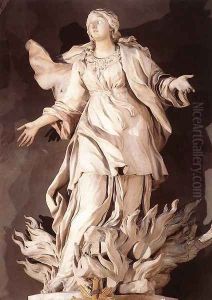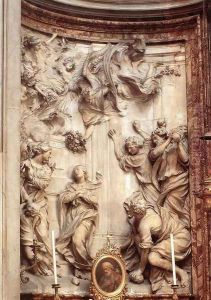Ercole Ferrata Paintings
Ercole Ferrata was an Italian sculptor of the Roman Baroque period, born in 1610 in Pellio Inferiore, Duchy of Milan (now Italy). His initial training began in Milan, but he is most famously associated with his work and career in Rome, where he moved in the 1630s. Ferrata became a prominent sculptor working under the tutelage and influence of Alessandro Algardi, one of the leading Baroque sculptors of the time, whose style was characterized by its dramatic realism and emotional expressiveness, in contrast to the more theatrical approach of his contemporary Gian Lorenzo Bernini. Despite this, Ferrata's career would also be significantly influenced by Bernini, under whom he worked as an assistant, contributing to some of the era's most significant projects.
Ferrata's works are exemplary of the Baroque style, noted for their dynamic movement, intricate details, and the dramatic play of light and shadow. Among his notable works is the statue of Saint Agnes on the altar of Sant'Agnese in Agone in Rome, a commission that showcases his ability to imbue marble with a tender softness and emotional depth. Another significant contribution is his work on the Tomb of Pope Alexander VII in St. Peter's Basilica, where he completed the figure of Charity, one of the four virtues surrounding the monument, after the death of its original sculptor.
In addition to his sculptural works, Ferrata was involved in restoration projects, notably restoring ancient statues, which was a common practice among artists of his time, blending a deep respect for antiquity with the contemporary Baroque aesthetics. His teaching and mentorship of other artists also contributed to his lasting legacy, with several notable sculptors of the next generation, including Melchiorre Cafà, emerging from his workshop.
Ercole Ferrata's career spanned over five decades, during which he contributed significantly to the artistic landscape of Baroque Rome. His work reflects the period's complex interplay between tradition and innovation, religious devotion, and artistic expression. He died in 1686 in Rome, leaving behind a body of work that continues to be admired for its craftsmanship and emotional resonance.

